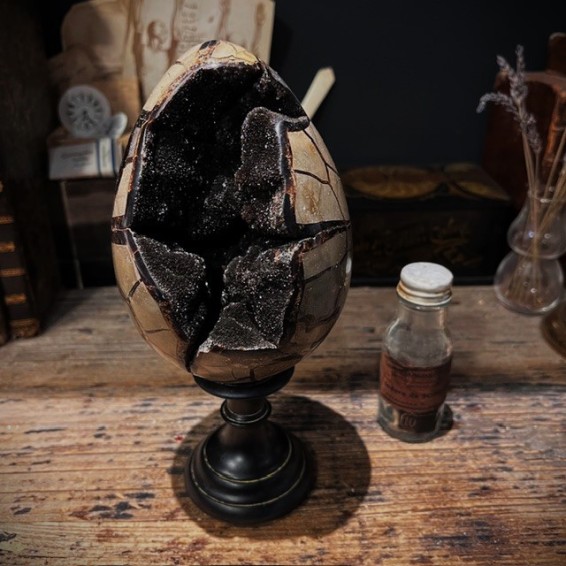
Display for ball or ostrich egg (Large)
High base specially designed to hold a ball or egg
Perfect for ostrich eggs
Not suitable for emu, rhea or swan eggs, for example







Dragon Stone
Septaria egg of Madagascar
Septaria Madagascar egg
Also known as Dragon Stone
Septaria is a stone composed of a mixture of yellow calcite and sandstone, found mainly on the island of Madagascar, characterized by highly visible shrinkage cracks. These highly visible cracks, known as Septa, fill with minerals over time.
When the stone is polished, these cracks stand out, giving it a dragon's egg appearance on the outside.
With time, tectonic movements, etc., the nodules can be fractured and new mineral solutions can invade the shrinkage cracks, often calcite.
In our case, Septaria has been polished into an egg shape and the interior has been invaded by a very fine crystallization of calcite. Beautiful crystals.
It's also easy to see why it's called Dragon's Stone: the exterior is very similar to a dragon's egg!
Sold without base
Ref OSM171: Weight: 1.9kg - Height: 14cm
Sold without the base
You can find available bases by typing ball base or egg base in the site search.
High base specially designed to hold a ball or egg
Perfect for ostrich eggs
Not suitable for emu, rhea or swan eggs, for example
Wooden base for ball or sphere - Base - support
Grey-Black patinated marble base for ball or sphere
Base - support
Madagascar sawyer ammonite - Cleoniceras fern ammonite
Cleoniceras fern ammonite
100 million year old fossil
Double skeleton
Sculpture on deer antlers
Unique piece
Dragon Stone
Septaria egg of Madagascar
Entomological box
Composition with South American butterflies
Morpho and heliconius
Dragon Stone
Septaria egg of Madagascar
Clastic Mannequin - Dr. Auzoux's anatomical skinned
Entomological box: Beetles Goliathus meleagris from Congo
One with spread wings
Memento Mori sculpted from a deck of cards - Poker
Size M
RED color
Crucifix crab - Giant crab on wooden pedestal
Charybdis feriata
Origin: Philippines
Australian saltwater crocodile skull: Crocodylus porosus
Estuary crocodile
With its CITES permit
33cm
Can only be sold in the European Union- Shengen Area
Common magpie on branch
Pica pica
Antique taxidermy with defects
Perfect in a cabinet of curiosities, a masterpiece!
Australian saltwater crocodile skull: Crocodylus porosus
Estuary crocodile
With its CITES permit
29cm
Can only be sold in the European Union- Shengen Area
Australian saltwater crocodile skull: Crocodylus porosus
Estuary crocodile
With its CITES permit
32cm
Can only be sold in the European Union- Shengen Area
Madagascar sawyer ammonite - Cleoniceras fern ammonite
Cleoniceras fern ammonite
100 million year old fossil
Dictionnaire Universel des Drogues Simples
Universal dictionnary of Simple Drugs
By Nicolas Lemery
Antique illustrated pharmacopoeia - 1760
Madagascar sawyer ammonite - Cleoniceras fern ammonite
Cleoniceras fern ammonite
100 million year old fossil

Dragon Stone
Septaria egg of Madagascar







